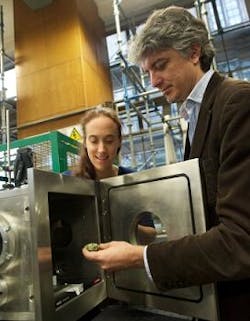Laser-based asteroid deflection goal of University of Strathclyde engineers
Glasgow, Scotland--University of Strathclyde engineers are developing a new laser-based technique that uses a swarm of relatively small satellites flying in formation and cooperatively firing solar-powered lasers onto an asteroid to deflect its path. This could overcome the difficulties associated with current methods that are focused on large, unwieldy spacecraft.
"The use of high power lasers in space for civil and commercial applications is in its infancy and one of the main challenges is to have high power, high efficiency and high beam quality all at the same time," says Massimiliano Vasile of Strathclyde's Department of Mechanical and Aerospace Engineering, who is leading the research. "The additional problem with asteroid deflection is that when the laser begins to break down the surface of the object, the plume of gas and debris impinges the spacecraft and contaminates the laser. However, our laboratory tests have proven that the level of contamination is less than expected and the laser could continue to function for longer than anticipated."
While the likelihood of an immediate threat from an asteroid striking earth is low, it is widely recognized that researching preventative measures is of significant importance. "We could reduce the threat posed by the potential collision with small to medium size objects using a flotilla of small agile spacecraft each equipped with a highly efficient laser which is much more feasible than a single large spacecraft carrying a multi mega watt. Our system is scalable, a larger asteroid would require adding one or more spacecraft to the flotilla, and intrinsically redundant—if one spacecraft fails the others can continue," says Vasile.
Vasile is also investigating the use of the same concept to remove space debris. "The amount of debris in orbit is such that we might experience a so called Kessler syndrome—this is when the density becomes so high that collisions between objects could cause an exponentially increasing cascade of other collisions," adds Vasile. "A major advantage of using our technique is that the laser does not have to be fired from the ground. Obviously there are severe restrictions with that process as it has to travel through the atmosphere, has a constrained range of action and can hit the debris only for short arcs."
The research was carried out in collaboration with the University of Strathclyde's Institute of Photonics and was presented to the Planetary Society at the end of February.
SOURCE: University of Strathclyde; www.strath.ac.uk/press/newsreleases/headline_602313_en.html

Gail Overton | Senior Editor (2004-2020)
Gail has more than 30 years of engineering, marketing, product management, and editorial experience in the photonics and optical communications industry. Before joining the staff at Laser Focus World in 2004, she held many product management and product marketing roles in the fiber-optics industry, most notably at Hughes (El Segundo, CA), GTE Labs (Waltham, MA), Corning (Corning, NY), Photon Kinetics (Beaverton, OR), and Newport Corporation (Irvine, CA). During her marketing career, Gail published articles in WDM Solutions and Sensors magazine and traveled internationally to conduct product and sales training. Gail received her BS degree in physics, with an emphasis in optics, from San Diego State University in San Diego, CA in May 1986.
